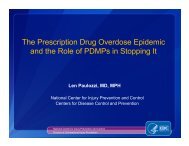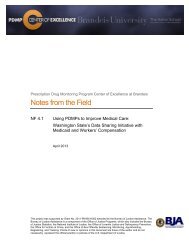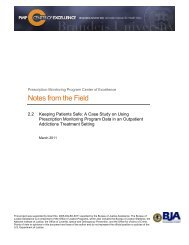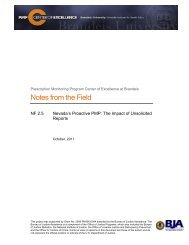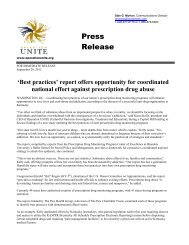Rx for Peril - The Health Insurance Impact and Risks of Epidemic ...
Rx for Peril - The Health Insurance Impact and Risks of Epidemic ...
Rx for Peril - The Health Insurance Impact and Risks of Epidemic ...
You also want an ePaper? Increase the reach of your titles
YUMPU automatically turns print PDFs into web optimized ePapers that Google loves.
<strong>Rx</strong> <strong>for</strong> <strong>Peril</strong><br />
<strong>The</strong> <strong>Health</strong> <strong>Insurance</strong> <strong>Impact</strong> <strong>and</strong> <strong>Risks</strong><br />
<strong>of</strong><br />
<strong>Epidemic</strong>-Level Prescription-Drug Diversion<br />
William J. Mahon<br />
<strong>The</strong> MAHON Consulting Group LLC<br />
PDMP Center <strong>of</strong> Excellence Conference<br />
Washington, DC<br />
December 3, 2012<br />
1
Promethazine with Codeine<br />
• DEA Schedule V narcotic—i.e.,<br />
lowest relative potential <strong>for</strong><br />
abuse<br />
• Retail price: $3 - $4 per ounce<br />
• Number 108 in 2010 script<br />
volume among US’ Top 200<br />
drugs<br />
• Number-9 in one client plan’s<br />
Top 10 scripts by total drug units<br />
2
Promethazine with Codeine—<strong>The</strong> Alter Ego<br />
• “Syrup. . . Sizerp. . .<br />
Purple Drank. . .<br />
Drank. . . Lean”<br />
• Street value: $7.50 -<br />
$10 per ounce<br />
• Abuse celebrated in<br />
rap/hip-hop music<br />
culture<br />
3
Three-Six Mafia: “Sippin’ on some siz-erp. . .”<br />
4
<strong>The</strong> Inevitable Knock<strong>of</strong>f. . .<br />
7
Houston: “City <strong>of</strong> Lean”<br />
8
Callie Hall-Herpin, MD<br />
9
Callie Hall-Herpin, MD<br />
• Fabricated <strong>and</strong> sold thous<strong>and</strong>s <strong>of</strong> prescriptions to street<br />
dealers in exchange <strong>for</strong> cash<br />
• 1,700,000 hydrocodone tablets<br />
• 2,500 gallons <strong>of</strong> promethazine with codeine<br />
• Proceeds: $1.7 million<br />
• Sentence:<br />
• 10 years federal prison + 3 years supervised release<br />
• $12.9 million restitution to Medicare program<br />
• Judge’s special order: May never again call herself “Doctor” & must<br />
immediately correct anyone who does so—OR be sent back to prison<br />
10
Alonzo Peters, MD<br />
• Allegedly taught Callie Hall-<br />
Herpin the prescription-mill<br />
business<br />
• Money-laundering (involving<br />
purchase <strong>of</strong> 33-carat<br />
diamond ring) + aiding <strong>and</strong><br />
abetting same<br />
• Sentence:<br />
• 5 years federal prison + 3 years<br />
supervised release<br />
• $10,000 assessment<br />
11
Florida: “<strong>The</strong> Colombia <strong>of</strong> Prescription Drugs”<br />
• DEA “Operation Pill Nation”:<br />
Two-year en<strong>for</strong>cement action<br />
• August, 2012 “pain clinic”<br />
arrests in Pompano Beach,<br />
Florida<br />
• 7 physicians, 3 clinic owners,<br />
one relative<br />
• Racketeering, drug trafficking,<br />
money laundering<br />
• Estimated physician <strong>Rx</strong><br />
revenue: $10,000 per week<br />
• 7 vehicles & 11 weapons<br />
seized<br />
12
“Drug Diversion” Defined. . .<br />
• U.S. Government Accountability Office:<br />
“Channeling <strong>of</strong> licit pharmaceuticals <strong>for</strong> illegal purposes or<br />
abuse”<br />
• UN Office on Drugs <strong>and</strong> Crime:<br />
“Non-Medical Use = Use by the person the drug was<br />
prescribed <strong>for</strong>, but not in the prescribed manner or dosage, as<br />
well as use by another person”<br />
13
Potential Diversion Perpetrators. . .<br />
• Patients—i.e., drug-seekers/“doctor shoppers”<br />
• Bogus patients—i.e., prescription buyers<br />
• Prescribers (MD/DOs, dentists, nurse practitioners,<br />
veterinarians) <strong>and</strong> prescriber employees<br />
• Dispensers <strong>and</strong> dispenser employees (pharmacists, pharmacy<br />
technicians)<br />
• Street dealers/patient recruiters<br />
• Pharmaceutical wholesalers<br />
• Large-scale pharmaceutical thieves<br />
• Various combinations <strong>of</strong> the above<br />
14
US: “A Perfect Storm <strong>of</strong> Abuse. . .”<br />
• 9% <strong>of</strong> US population age 12 or older—22.6 million persons—<br />
acknowledge illicit drug use in 2010<br />
• <strong>Rx</strong> abuse is second only to cannabis—exceeds cocaine, heroin<br />
& hallucinogen abuse combined<br />
• High incidence among teenagers (Vicodin, OxyContin,<br />
stimulants, sedatives)<br />
• 1/3 <strong>of</strong> all new abusers typically are 12 to 17-year-olds<br />
15
A Global Phenomenon<br />
• UN Office on Drugs <strong>and</strong> Crime: “Growing non-medical use<br />
<strong>of</strong> prescription drugs is a global health concern.”<br />
– Opioids, CNS depressants, CNS stimulants<br />
– “Drug traffickers responding to dem<strong>and</strong>”<br />
• Canada: 0.6% past-year non-medical use—opioid use<br />
exceeds heroin<br />
• Australia: Past-year non-medical opioid use by 2.5% <strong>of</strong> adult<br />
population—exceeds heroin & cocaine<br />
• South America: “Non-medical use <strong>of</strong> <strong>Rx</strong> opioids accounts <strong>for</strong><br />
most <strong>of</strong> the use <strong>of</strong> opioids”—Costa Rica annual prevalence =<br />
2.8% <strong>of</strong> population<br />
• Europe, Northern Irel<strong>and</strong>: “Highest annual prevalence <strong>of</strong><br />
<strong>Rx</strong> opioids anywhere in world” at 8.9% 17
A Global Phenomenon<br />
• Europe, France: “Buprenorphine diverted to illicit market <strong>and</strong><br />
<strong>of</strong>ten winds up in Finl<strong>and</strong>”<br />
• Europe, UK: 2011 GP survey indicates nearly 80% “routinely<br />
prescribe drugs to which they believe the patient may be<br />
addicted” (BBC)<br />
• Asia: Benzodiazepines predominate<br />
• India, Bangladesh, Nepal: “Illicit use <strong>of</strong> injected<br />
buprenorphine is common”<br />
• Gulf States, Dubai: 2010 overdose deaths spark new<br />
government warnings/en<strong>for</strong>cement initiatives<br />
• Singapore: Subutex/buprenorphine re-classified as illegal<br />
drug following surges in abuse<br />
18
http://www.guardian.co.uk/news/datablog/interactive/2012/jul/02/drug-use-map-world<br />
19
US: Not A New Phenomenon . . .<br />
• First observed in Civil War re: Morphine theft<br />
• 1987: Establishment <strong>of</strong> National Association <strong>of</strong> Drug Diversion<br />
Investigators (NADDI)<br />
• 1990: Cincinnati, Ohio Police Department establishes Drug Diversion<br />
Squad—500 Cases/Yr by 1993<br />
• 1992: GAO study cites diversion as “prevalent type <strong>of</strong> Medicaid<br />
fraud”<br />
• 1992: FBI “Operation Goldpill”—3 years, 50 cities, 200 pharmacists &<br />
other perpetrators<br />
20
US: However. . . A New Drug-Funding Equation<br />
• <strong>Rx</strong> Costs, 1990: " "$40.3 Billion!<br />
– Government: " "18%"<br />
– Private <strong>Insurance</strong>:" "26%"<br />
– Consumers: ! !56% !<br />
"<br />
• <strong>Rx</strong> Costs, 2005: " "$200.7 Billion!<br />
– Consumers: " "25%"<br />
– Government: " "28%"<br />
– Private <strong>Insurance</strong>: !47%!<br />
21
US Controlled-Substance Consumption<br />
1992 - 2002<br />
• U.S. Population: " " "+ 13%"<br />
" " ""<br />
• Non-Controlled Drugs:" " "+ 57%"<br />
"<br />
• Controlled Drugs: " " "+ 154%"<br />
"<br />
– Opioids: " " "+ 222%"<br />
"<br />
• Hydrocodone: " "+ 376%"<br />
• Oxycodone: " "+ 380%"<br />
– Benzodiazepines: " "+ 49%"<br />
– Stimulants: " " "+ 369% ""<br />
22
Drugs in Dem<strong>and</strong>. . .<br />
• Schedule II ! ! !Retail $! !Street $!<br />
!<br />
– Opana ER 40mg " "$7.75/tablet "$90/tablet"<br />
– Oxycontin 40mg " "$5.66/tablet "$20–$40/tablet"<br />
– oxycodone 40mg " "$4.54/tablet "$6–$8/tablet"<br />
– morphine 100mg " "$4.16/tablet "$60/tablet"<br />
– Actiq 400mg " "$26/lozenge "$30–$40/lozenge"<br />
– fentanyl 50mcg " $24/patch "$25–$40/patch"<br />
– methadone " " "$0.21/tablet "$10–$20/tablet"<br />
– Ritalin " " "$1.11/tablet $8–$15/tablet"<br />
– Adderal " " "$4.23/tablet "$5-$7/tablet"<br />
"<br />
• Schedule III!<br />
!<br />
– Vicodin* " " "$1.47/tablet "$6–$10/tablet"<br />
– hydrocodone/APAP " " $0.43/tablet " $6–$10/tablet"<br />
* Could become Schedule II following October, 2012 review"<br />
23
Drugs in Dem<strong>and</strong>. . .<br />
• Schedule IV ! ! !Retail $! !Street $!<br />
!<br />
– Valium " " "$3.30/tablet "$4/tablet"<br />
– diazepam " " "$0.39/tablet $4/tablet"<br />
– Adipex (phentermine) "$2.13/tablet $3–$6/tablet"<br />
– Xanax 2mg" " "$3.28/tablet "$4/tablet"<br />
– alprazolam " " "$0.42/tablet "$4/tablet"<br />
– carisoprodol/Soma* " "$0.20/tablet "$1 - $5/tablet*"<br />
• Schedule V!<br />
!<br />
– promethazine with codeine "$3.35/fl.oz. "$7.50–$10/fl.oz. <br />
* Became federal (DEA) controlled substance 1/12"<br />
24
Drugs to Watch. . .<br />
• Buprenorphine (Subutex/Suboxone)"<br />
"<br />
– May be prescribed by physicians <strong>for</strong> opioid dependency"<br />
– Enlarged patient base authorized 12/06"<br />
– DEA: Becoming a “primary drug <strong>of</strong> abuse”"<br />
"<br />
• Methadone (Dolophine/Methadose)"<br />
"<br />
– #1 fatal narcotic in 2004—<strong>and</strong> more so every year"<br />
– Bifurcated prescribing/dispensing scheme—heroin addiction/pain"<br />
– 2006 FDA Public <strong>Health</strong> Advisory: “Methadone Use <strong>for</strong> Pain Control"<br />
May Result in Death” (especially if combined with Xanax)"<br />
– Least expensive/most deadly"<br />
– Low cost appeals to public-assistance programs"<br />
• Newer narcotics"<br />
• Opana ER (“O-Bomb”)—abuse & overdose deaths surging in 2012"<br />
• Norco—”Vicodin on steroids”"<br />
25
Diversion’s Dire Consequences. . .<br />
• 2002: Fatal pain-med poisonings surpass cocaine & heroin deaths"<br />
"<br />
• 2009: At 37,485 fatalities, accidental drug overdose surpass traffic fatalities to"<br />
become #1 cause <strong>of</strong> unintentional-injury death in U.S."<br />
– Prescription-narcotic deaths exceed 15,500"<br />
– Up 78% between 1999 <strong>and</strong> 2004: Sedatives, Vicodin, Oxycontin cited as"<br />
principal factors"<br />
– Up more than 100% in 23 US states (e.g., 550% in West Virginia)"<br />
"<br />
2005: 43% <strong>of</strong> drug-abuse E.R. visits—600,000—involve pharmaceuticals"<br />
"<br />
• 2003: Acetaminophen poisoning becomes #1 cause <strong>of</strong> acute liver failure"<br />
in U.S."<br />
• 2005: Annual U.S. liver transplants up 20% since 2001. First-year costs:"<br />
$393,000"<br />
26
Key Observations. . .<br />
• Question not so much “What are payers finding when they"<br />
look” as it is “To what extent are payers looking”"<br />
• Most outsource <strong>Rx</strong> benefit/processing to pharmacy-benefit"<br />
management companies (PBMs)"<br />
• Widespread perception that few PBMs engage in true fraud-detection"<br />
<strong>and</strong> investigation activity (e.g., vs. routine pharmacy audits)"<br />
• Issue not addressed in many insurer - PBM relationships"<br />
"<br />
• Even some health insurers with captive PBMs don’t focus on <strong>Rx</strong> "<br />
27
Three-Dimensional Cost <strong>Impact</strong>. . .<br />
• Unnecessary, excessive or fraudulent prescriptions"<br />
• Related medical claims—legitimate or falsified"<br />
– Physician <strong>of</strong>fice visits & other treatments"<br />
– Diagnostic tests (imaging, nerve conduction)"<br />
– Emergency room/urgent care clinic exams/treatments"<br />
– Conditions caused by <strong>Rx</strong> abuse—e.g., liver damage/failure"<br />
– Treatment <strong>of</strong> affected family members"<br />
• Incalculable potential-liability cost"<br />
– Dangerous prescribers/prescription sellers"<br />
– Insured’s injury or death"<br />
– Insured’s injury <strong>of</strong> others"<br />
28
Key Observations. . .<br />
• Experts’ consensus: High-cost provider cases abound, but doctor"<br />
shopping is most common—<strong>and</strong> costly—<strong>for</strong>m <strong>of</strong> diversion "<br />
– Aetna: 48% <strong>of</strong> member-fraud investigations involve <strong>Rx</strong> "<br />
• Low-cost cases "<br />
– Natl. Assn. <strong>of</strong> Drug Diversion Investigators: Typical doctorshopper<br />
sees 5 - 10 prescribers, costs payer $10,000 -<br />
$15,000/yr <strong>Rx</strong> + medical"<br />
– MEDCO, 2005: “High-utilization” members’ <strong>Rx</strong> costs 7x norm"<br />
"<br />
• Sole focus on <strong>Rx</strong> costs overlooks the far-greater impact!<br />
29
WellPoint/Anthem BCBS <strong>of</strong> Virginia<br />
100 members with multiple narcotic <strong>Rx</strong> scripts from 5 or "more<br />
sources in 90-day period:"<br />
• Prescribers: " " "689"<br />
• Pharmacies: " " "608"<br />
• Narcotic Scripts:" " "1,217"<br />
• Paid Narcotic <strong>Rx</strong> claims: " "$20,233"<br />
• Medical claims <strong>for</strong> same 100 members, same 90-day"<br />
period:"<br />
• Office visits: " " "4,131"<br />
• Outpatient Facility Visits: " "958"<br />
• Total Medical Claim $: " "$832,172"<br />
• Average medical-to-<strong>Rx</strong> cost ratio: "$41 to $1"<br />
"<br />
• Full-year 100-member savings following intervention &"<br />
pharmacy restriction: $333,418 "<br />
30
<strong>The</strong> Analysis Group, Inc.<br />
“Direct Costs <strong>of</strong> Opioid Abuse In An Insured Population”"<br />
"—J Managed Care Pharmacy, July/August 2005"<br />
"—1998 - 2002 claim data from 2-million member database"<br />
—Aged 12 - 64, continuous enrollment 12 months <strong>of</strong> study"<br />
—”Abuser” = at least 1 non-heroin opioid abuse/dependence/poisoning ICD-9"<br />
code in claim history in or within 12 months pre- or post-study period "<br />
• Diagnosed opioid abusers’ “total health costs 8 times those <strong>of</strong> non-"<br />
abusers’”"<br />
" " "Non-Abusers " "Abusers"<br />
—Drug " "$386 " " "$2,034"<br />
—Inpatient " "$318 " " "$7,659"<br />
—Physician/OP "$928 " " "$5,398"<br />
—Other (E.R. +) "$198 " " "$793"<br />
"<br />
TOTAL " "$1,830 " " "$15,884"<br />
"<br />
Excess Annual Cost "(2003 $) " " " $14,054 " ""<br />
" " "(2012 $) " " " $17,499*"<br />
31
Sobering Scenarios: Insured Population. . .<br />
• “Fully Loaded”—1.9% insured opioid abusers @ avg. excess cost:"<br />
– 4.85 million x $16,485 = $79.9 billion/yr"<br />
• “More Conservative”—1.9% insured opioid abusers @ avg. excess cost,"<br />
less in-patient $:"<br />
– 4.85 million x $8,572 = $41.6 billion/yr"<br />
• Most Conservative—1% insured opioid abusers at reduced avg. excess"<br />
cost:"<br />
– 2.6 million x $8,572 = $22.3 billion/yr"<br />
32
Sobering Scenarios: Individual Plan-Level<br />
• “Most Conservative” excess-cost math applied to plan sizes:"<br />
– 10 million lives @ 1% abusers"<br />
• 100,000 members x $8,572 =<br />
"$857,000,000/yr"<br />
– 1 million lives @ 1% abusers:"<br />
• 10,000 members x $8,572 =<br />
"$85,700,000/yr"<br />
– 500,000 lives @ 1% abusers:"<br />
• 5,000 members x $8,572 =<br />
"$42,900,000/yr"<br />
– 250,000 lives @ 1% abusers:"<br />
• 2,500 members x $8,572 =<br />
"$21,400,000/yr!<br />
33
<strong>The</strong> Incalculable Payer Liability Risk. . .<br />
• Payers that fail to take an active approach to doctor-shopping <strong>and</strong> other"<br />
aspects <strong>of</strong> diversion face significant potential liability related to prescription-"<br />
drug addiction <strong>and</strong> overdose deaths: "<br />
!“<strong>The</strong> data was right under the prescription payer’s nose; had it only<br />
taken the trouble to look at what it was paying <strong>for</strong>, it could have prevented<br />
this addiction . . . liver failure . . . overdose death . . . fatal accident”!<br />
"<br />
• Precedent <strong>for</strong> “should have known” suit against pharmacy"<br />
– Florida court decision affirms pharmacy’s “duty to warn” <strong>and</strong> to be more than"<br />
“a passive dispenser”"<br />
"<br />
• Credentialing & network-admission/retention issues also come into play"<br />
• Awareness <strong>of</strong> risk is integral aspect <strong>of</strong> some companies’ active approaches"<br />
• “Passive-payer” approach is inadequate <strong>and</strong> very risky in face <strong>of</strong> “national"<br />
epidemic” & widespread mortality"<br />
34
Key Observations. . .<br />
• Matching <strong>Rx</strong> claim data to medical claim data is essential but is the"<br />
industry exception, not the rule"<br />
"<br />
– Many payers don’t do it at all"<br />
– Some do it only with difficulty—technical <strong>and</strong> procedural"<br />
– A few have exemplary capability"<br />
• Many payers face obstacles—real or perceived—to implementing"<br />
effective intervention/pharmacy restriction programs"<br />
• Insurers have opportunities to curtail payment <strong>for</strong> <strong>of</strong>f-label uses <strong>of</strong>"<br />
specific drugs—e.g., Actiq, Gabapentin/Neurontin"<br />
• Opportunities abound <strong>for</strong> stronger point-<strong>of</strong>-sale controls"<br />
35
Broad Best Practices <strong>for</strong> <strong>Rx</strong> Payers. . .<br />
• Pay more attention!!<br />
"<br />
– Increase awareness <strong>of</strong> true impact <strong>and</strong> potential exposure, including at<br />
senior management levels"<br />
– Avail selves <strong>of</strong> PBM tools/intervention programs (best case)"<br />
– Force the issue in PBM relationship (worst case)"<br />
– Educate <strong>and</strong> enlist support <strong>of</strong> self-insured group customers"<br />
!<br />
!<br />
– Enlist expert pain-management counsel to assist in striking <strong>and</strong>"<br />
maintaining appropriate balance"<br />
"<br />
–Establish <strong>and</strong> maintain relationships with law en<strong>for</strong>cement diversion"<br />
specialists—be equipped to address the hard-core criminal component"<br />
"<br />
– Better underst<strong>and</strong> options <strong>for</strong> appropriate action—addiction assistance vs."<br />
law en<strong>for</strong>cement referral"<br />
36
Broad Best Practices <strong>for</strong> <strong>Rx</strong> Payers. . .<br />
"<br />
• Support effective Prescription Drug Monitoring Programs (PDMPs)"<br />
"<br />
• Address obstacles—real or perceived—to implementing effective intervention"<br />
measures—e.g., pharmacy restriction"<br />
"<br />
– Policy/contract/program terms"<br />
– Communication with prescribers"<br />
• Review <strong>and</strong> consider narrowing coverage policies re: Prescriptions <strong>for</strong> <strong>of</strong>f-label"<br />
uses!<br />
!<br />
!<br />
37
Operational Best Practices <strong>for</strong> <strong>Rx</strong> Payers. . .<br />
• Address IT <strong>and</strong>/or other obstacles to matching medical <strong>and</strong> <strong>Rx</strong> claim data"<br />
• Review drug <strong>for</strong>mularies <strong>and</strong> improve up-front controls"<br />
– Prior Authorizations"<br />
– Quantity Limits"<br />
– Encourage—if not require—network prescribers to query PMP databases"<br />
• Review <strong>and</strong> improve point-<strong>of</strong>-sale controls"<br />
– Date <strong>of</strong> Birth queries"<br />
– Photo Identification"<br />
• Don’t overlook lower-pr<strong>of</strong>ile drugs"<br />
– Promethazine w/Codeine"<br />
– Methadone"<br />
– Buprenorphine (Subutex/Suboxone)"<br />
• Develop <strong>and</strong> implement patient-pharmacy restriction programs!<br />
38
www.insurancefraud.org<br />
–”Tools”<br />
–“Publications”<br />
39
https://www.unodc.org/<br />
documents/data-<strong>and</strong>analysis/WDR2012/<br />
WDR_2012_web_small<br />
.pdf<br />
40
UN ODC Discussion Paper, 2011:<br />
“<strong>The</strong> Non-Medical Use <strong>of</strong> Prescription Drugs—Policy<br />
Direction Issues”<br />
http://www.unodc.org/docs/youthnet/<br />
Final_Prescription_Drugs_Paper.pdf<br />
41




